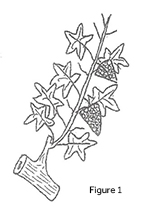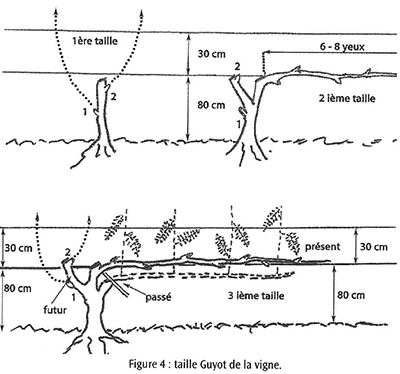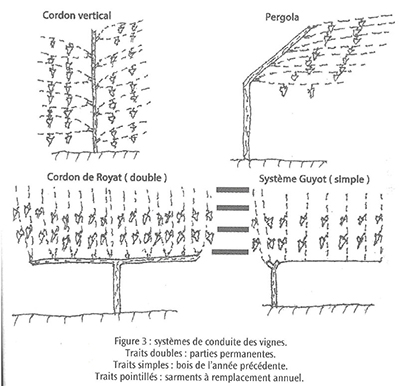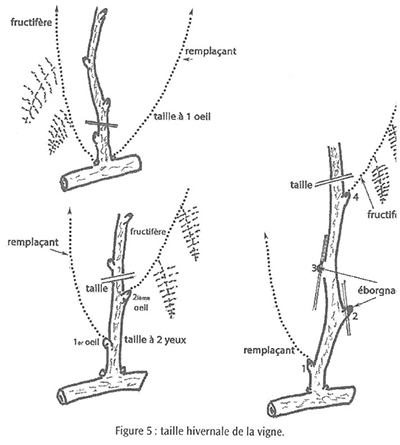Each species must be pruned according to its mode of fruiting. But winter pruning also depends on the way the plants have been formed, as well as their age.
Vine pruning is very important for the AgriWasteValue because this project aims to valorise these residues into bioactive compounds for cosmetic and nutraceutical uses and to allow to go to more "zero waste".
Vine pruning
The vines flower and bear fruit on the same year's branches (= the shoots) opposite the fourth or fifth leaf, then one or two nodes higher up (figure 1). We could deduce that whatever the variety and the shape of the framework (espalier, U, pergola, Royat or Guyot...), winter pruning consists in keeping a single bud at each place where we wish to see a shoot develop, and to eliminate all the rest of the vegetation of the previous year.
In a greenhouse, the vines are usually formed in a cordon (single axis) or a U shape (two axes 80-100 cm apart). In the open air, they are either formed as a vertical cordon, leaning against a wall or a counter-bearing, or formed as a Royat hedge or a Guyot hedge, or as a pergola (figure 3). There are still many other old or regional systems of vine training for wine vines.
Guyot hedge
In the Guyot hedge, the plants are 1m (single Guyot) to 1,5m (double Guyot) apart. The vine stock is the only permanent piece of framework; it will be 70-80cm high. One or two "long woods", vigorous one-year-old shoots planted at the top of the vine stock are kept, which are led horizontally (or arched) on the first wire. Another vigorous vine shoot is pruned on two eyes to obtain good replacements and the rest is removed (figure 4). This system is well suited for vigorous vines (soil quality + rootstock + variety). The shoots from the long woods are trellised vertically on 3 wires.
Royat cords and pergola
Vertical and pergola cords have a single vine; Royat cords (single or double) have a vertical vine of 70-80 cm, and one or two horizontal branches trellised at the first wire. In all these systems, the same annual pruning is applied (figure 5): the previous year's shoots 15 to 25 cm apart are pruned either on one eye, most often on two eyes, or on four eyes, depending on the variety. All other shoots are removed.
Pruning a vine on ... eye(s)
Pruning on one eye results in a single fruiting shoot, which the following year is pruned on its first good eye. Pruning on both eyes gives two shoots; the following year the basal shoot is in turn pruned on two eyes and the distal shoot is removed. After a few years, the crown is simplified by starting from a piercing.
In the four-eye pruning, the first and fourth eyes are retained. The first eye gives a non-fruitful replacement shoot, the second and third are removed; the fourth gives a fruitful shoot. The following year, the replacement shoot is pruned on four eyes and all the rest is removed.
What is done with the residues of pruning ?
Residues from pruning the vines are usually left on site by the winegrowers, as they do not have the time, the necessary equipment or the possibility to get rid of these residues easily once they are removed from the vineyard.
All this waste (it is estimated that 1 hectare of vines produces about 6 tons of residues) is a source of energy that is not yet sufficiently exploited. This is why AgriWasteValue is seeking to valorise these residues by exploiting the bioactive compounds that are stored there.
Source : Le Sillon Belge, n°3904, February 27, 2020




